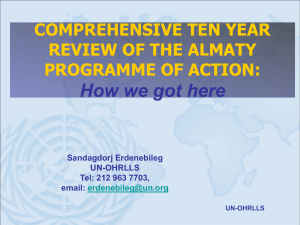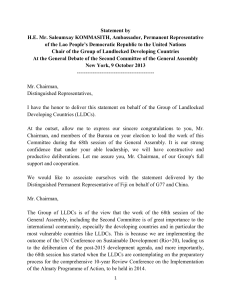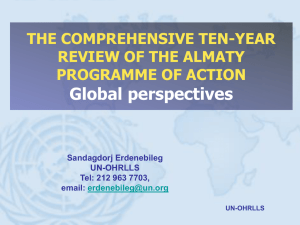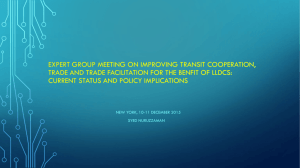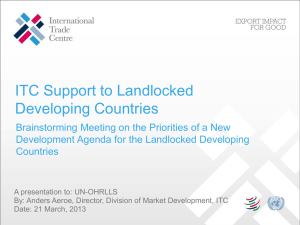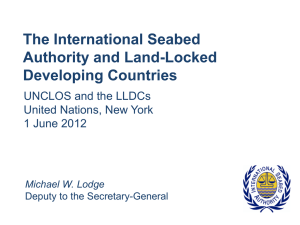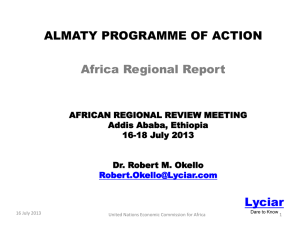The Economics and Costs of Landlockedness - UN
advertisement
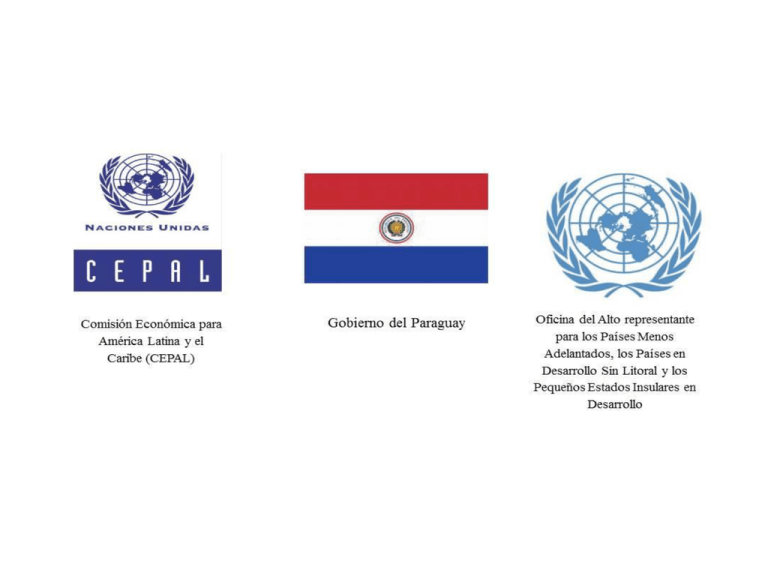
The Development Economics of Landlockedness UN-OHRLLS Sandagdorg Erdenebileg, Chief of Policy Development, Coordination, Reporting Service UN-OHRLLS Landlocked Developing Countries 4 2 10 15 Africa: Botswana, Burkina Faso, Burundi, Central African Republic, Chad, Ethiopia, Lesotho, Malawi, Mali, Niger, Rwanda, Swaziland, Uganda, Zambia, Zimbabwe Asia: Afghanistan, Bhutan, Kazakhstan, Kyrgyzstan, Lao, Mongolia, Nepal, Tajikistan, Turkmenistan, Uzbekistan Europe: Armenia, Azerbaijan, Macedonia, Moldova Latin America: Bolivia, Paraguay UN-OHRLLS Almaty Programme of Action Comprehensive development agenda, focused on transit cooperation Key objectives: • Increase export competitiveness through reducing trade transaction costs • Develop genuine partnerships at national, bilateral, subregional, regional and global levels -between LLDCs and transit countries with their development partners and between the private and public sectors Priority areas: i) Fundamental transit policy issues ii) Infrastructure development and maintenance iii) International trade and trade facilitation iv) International support measures UN-OHRLLS Development Challenges Linked to Landlockedness UN-OHRLLS Landlockedness affects development through various channels UN-OHRLLS Structural Deficiencies that LLDCs Face • Lack of diversification • Decline of value-addition in manufacturing and agricultural sector • Heavy reliance on low-value – high-bulk commodities which make LLDCs vulnerable to commodity price volatility • Limited productive capacities • High vulnerability to the global financial and economic crisis, food security, and climate change, including desertification, drought and land degradation UN-OHRLLS LLDCs trade less and pay more than coastal countries OHRLLS study applied a gravity model to data from 150 countries, including LLDCs and coastal countries over 19802010. Results: • LLDCs’ trade was just 61% of the trade volume of coastal countries in 2010. In 2004 it was 57%. • Transport costs for LLDCs were 45% higher than the representative coastal economy in 2010 and have increased over time. UN-OHRLLS Development Cost of Landlockedness The level of development in LLDCs is on average 20% lower than what it would be were the countries non-landlocked. Average UN-OHRLLS Declining Value Addition in Manufacturing and Agriculture in LLDCs UN-OHRLLS LLDCs unlikely to achieve MDGs by 2015 Poverty headcount ratio $1.25 per day (% of total pop) has decreased but still high 38 per cent of LLDC population still live on less than $1.25 per day and per person Half of LLDCs continue to have mortality rates in excess of 150 per 1000 live births Efforts to narrow the gender inequality have been recorded but much needs to be done in areas of education and labor market UN-OHRLLS Selected key achievements and challenges in the priority areas of the Almaty Programme of Action UN-OHRLLS LLDCs experienced high economic growth since 2003 Real GDP growth (percentage) 10 8 6 4 2 0 2003 2004 2005 2006 2007 2008 2009 2010 2011 -2 World LLDC average -4 UN-OHRLLS GDP per capita in LLDCs just over half that of transit countries World Developed 2010 All developing 2005 2000 1990 Transit developing 1980 Coastal developing Landlocked developing 0 5000 10000 15000 20000 25000 30000 35000 40000 UN-OHRLLS LLDCs have lowest percentage of paved roads: only 9 have greater than 50% Percentage of paved roads UN-OHRLLS Infrastructure Development and Maintenance • Notable regional initiatives for infrastructure development in Latin America. The Initiative for the Integration for the Regional Infrastructure of South America (IIRSA) included a list of 546 projects with an estimated investment of $150 billion including 474 transport projects estimated for $ 87 billion. • Asia - Progress has been made on the development of the Asian Highway and Trans-Asian Railway networks • Africa - implementing the PIDA; with support from partners (World Bank, EU, AfDB, JICA, South-South Corp etc.) transit corridors have been developed • Some progress in development of energy and ICT infrastructures => Sub-regional and regional cooperation on infrastructure projects should be enhanced => Explore innovative financing mechanisms including the use of PPPs UN-OHRLLS Trade Performance of LLDCs • LLDCs merchandise export were $230 billion in 2012, high growth following the sharp decline in 2009 • Fuel and mineral LLDC exporters experienced the largest gains • Over half of LLDCs exports originated in just two countries • LLDCs merchandise imports were $205 billion in 2012 • LLDCs’ share of world trade doubled since 2003, but remains low at 1.17% in 2012 UN-OHRLLS Export Concentration has been increasing 0.5 0.4 0.4 0.3 0.3 0.2 0.2 0.1 0.1 0.0 2000 2001 2002 2003 2004 Developing economies 2005 2006 2007 2008 Developed economies 2009 2010 2011 LLDCs UN-OHRLLS Average LLDCs exports are highly concentrated in just a number of products On average, just 3 export products constitute 61% of exports in LLDCs UN-OHRLLS Trade Facilitation Measures Developed include • One-stop border posts • Broader application of information technology • Adoption of Common/Single Customs Documents (MERCOSUR: DUAM) • Single window processing • Harmonization of road transit charges and road customs transit declaration documents • Harmonization of axle load limits • Third party motor insurance schemes • Increased accession to international transport and transit conventions and regional and sub-regional transit agreements UN-OHRLLS Despite efforts at facilitating trade across borders, it takes almost twice as long and is twice as expensive for LLDCs Import LLDCs 2006 LLDCs 2013 Transit countries 2013 Number of documents 11 10 8 Number of days 57 48 27 $2,688 $3,643 $1,567 Number of documents 9 8 8 Number of days 48 42 23 $2,207 $3,040 $1,268 Cost per container Export Cost per container UN-OHRLLS Trade facilitation negotiations under the Doha Round • Trade Facilitation in the Doha Development Round has the potential to address many of the fundamental transit policy issues that affect LLDC exports • Negotiations aim to clarify and improve relevant aspects of Articles V, VIII and X of the GATT 1994 with a view to further expediting the movement, release and clearance of goods, including goods in transit • A WTO Trade Facilitation Agreement could bring down the global cost of moving trade today from roughly 10 per cent of trade value to 5 per cent. • OECD estimates that the Agreement would bring down trade costs in LLDCs by 16.4% • Still hope that the 9th WTO Ministerial in Bali will deliver an agreement. UN-OHRLLS International support and financial flows to LLDCs since 2003 • ODA to LLDCs: $25.7 billion in 2011, 60% real increase between 2003 and 2010, but 3.3% fall in 2011 as result of fiscal austerity • Aid for Trade: $6.4 billion in 2011, a double of the 2002-2005 level • FDI inflows: $34.6 billion in 2012, up from $8.9 billion in 2003, but only 5% of world total • Remittances: $22 billion in 2012, up from $4 billion in 2003 But resources are highly concentrated towards only a handful of LLDCs UN-OHRLLS Global awareness and recognition of special needs of LLDCs has increased since APoA UN-OHRLLS The Way Forward • Reduce high trade transaction costs • Enhance productive capacities, value addition, diversification and reduction of dependency on commodities • Address inadequate infrastructure • Strengthen legal framework, international, regional, subregional and bilateral agreements • Enhance regional integration • Increase financial resources, ODA, FDI, remittances • Enhance capacity to address impact of global trends: slow down of economic development triple crisis, climate change, desertification • Mainstream LLDCs issues into global post-2015 development agenda, SDGs • Strengthen role and contributions of international regional organizations UN-OHRLLS Thank You UN-OHRLLS
